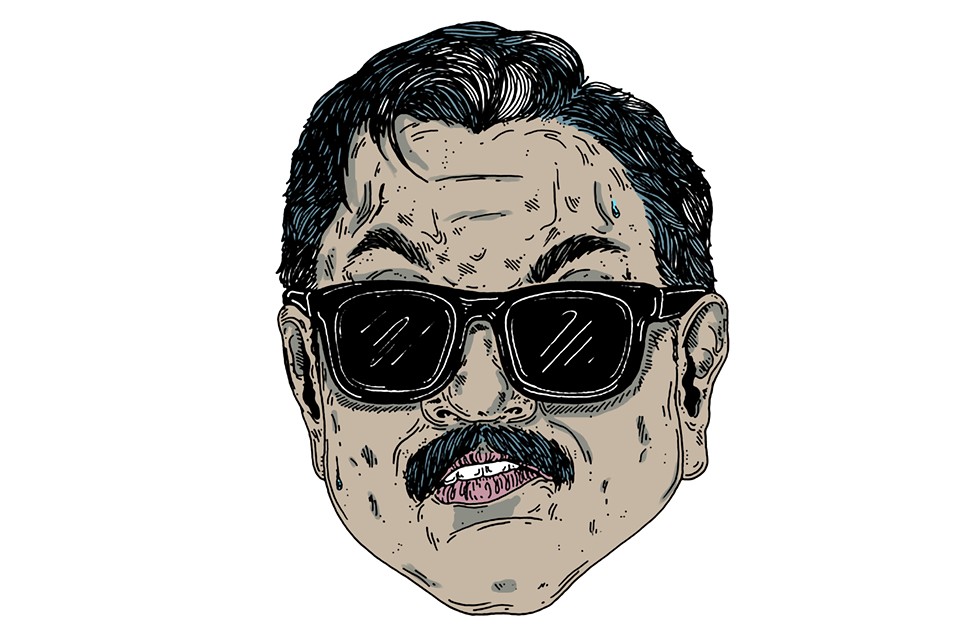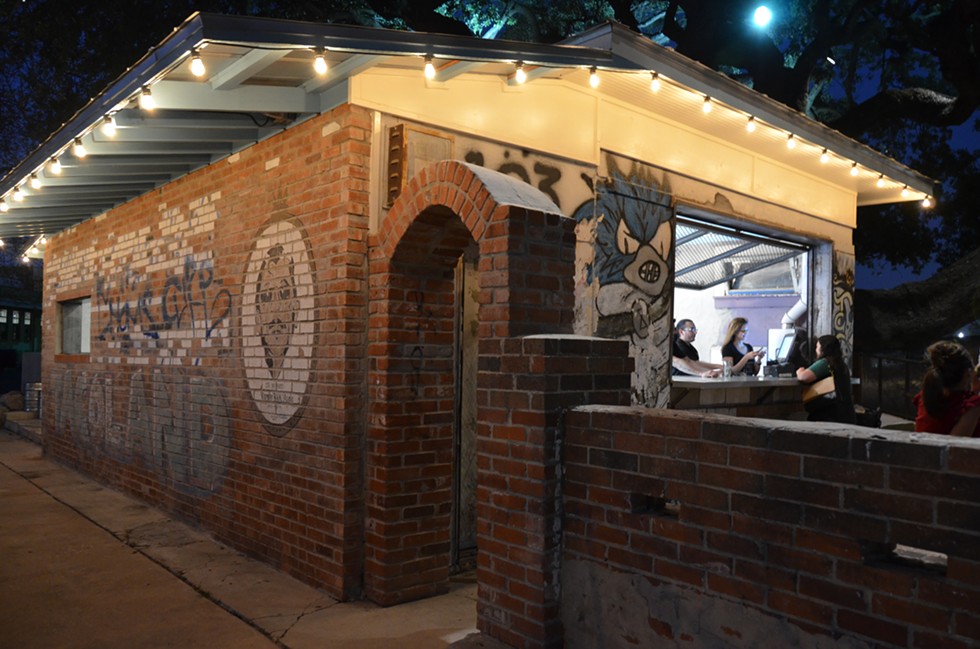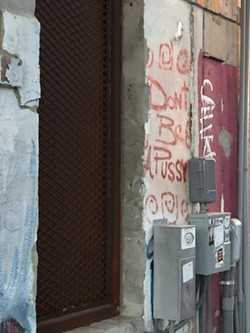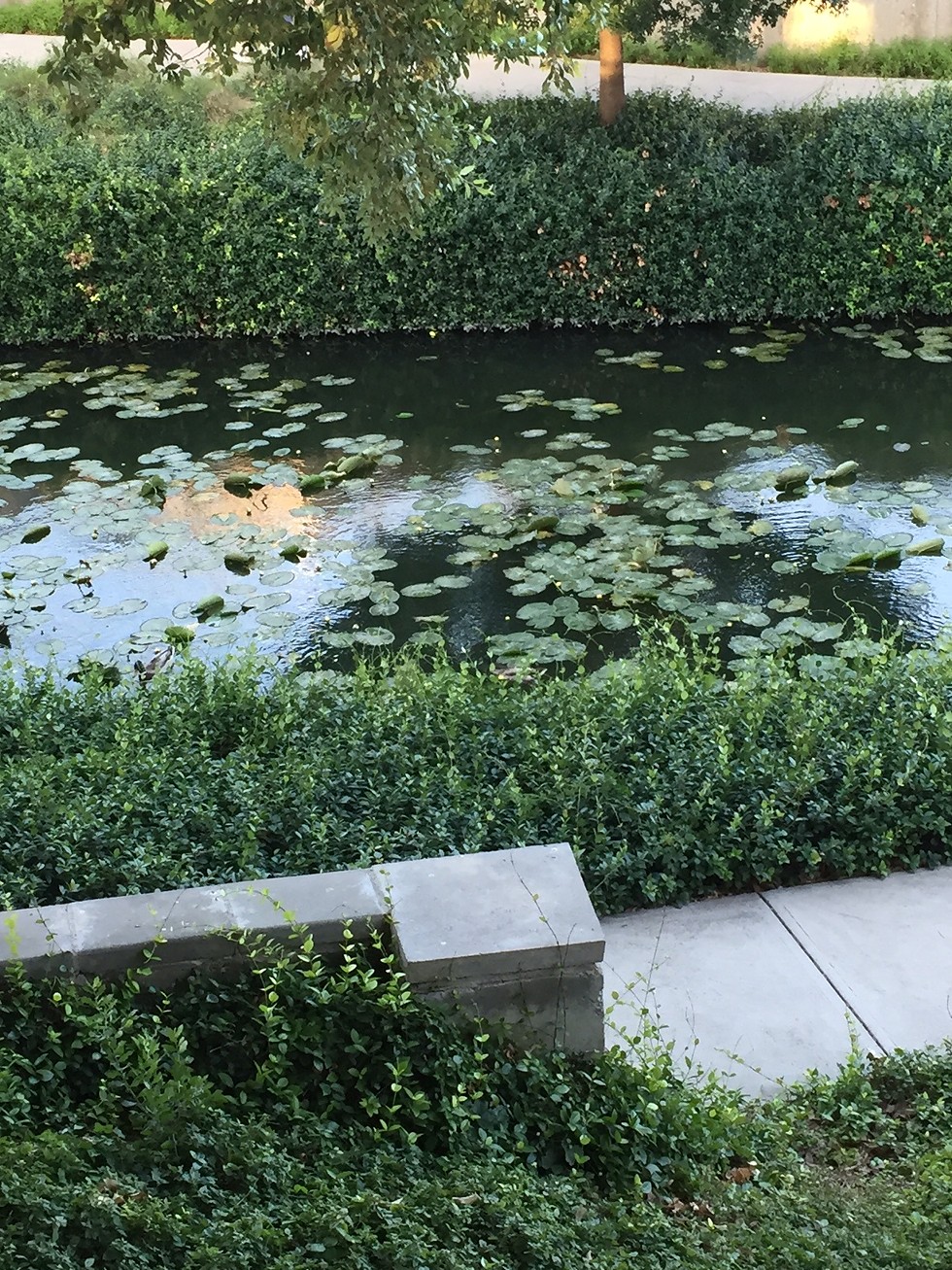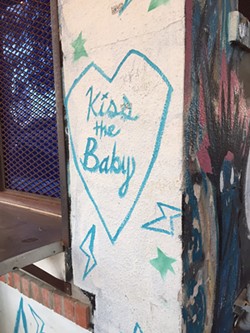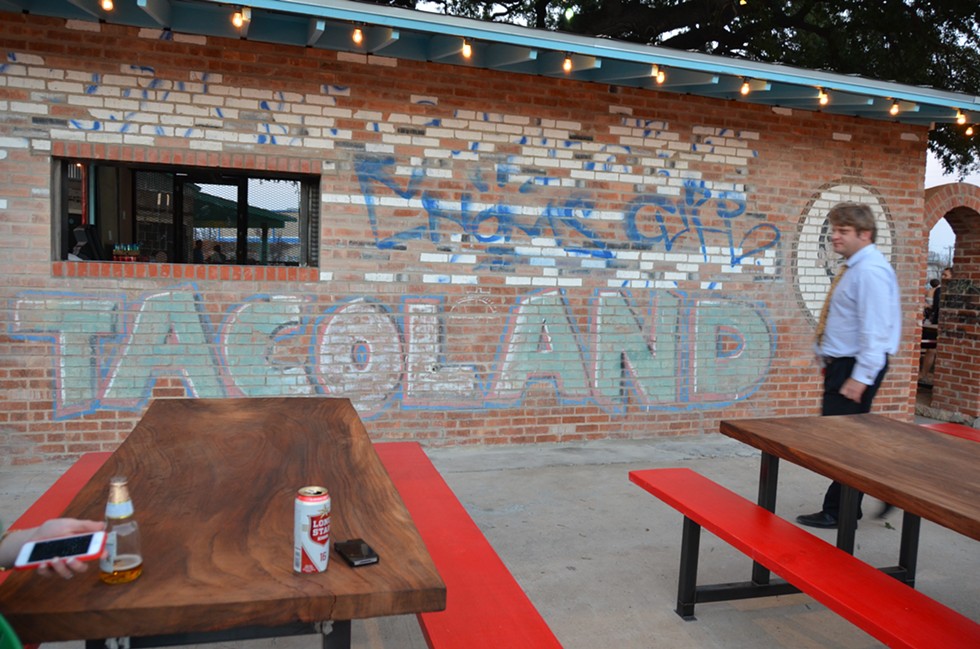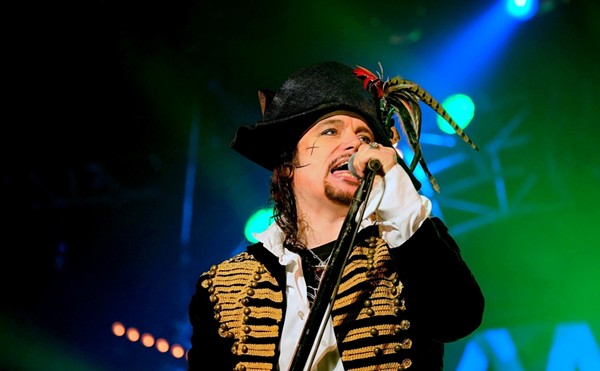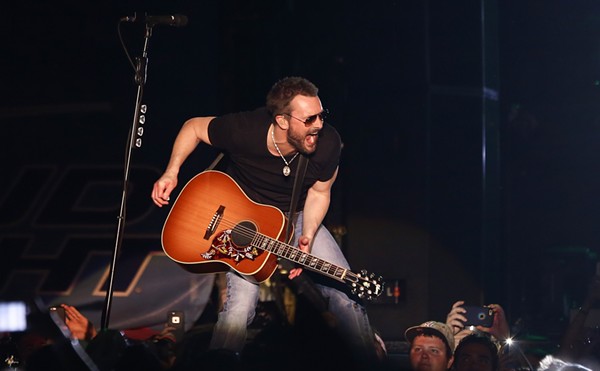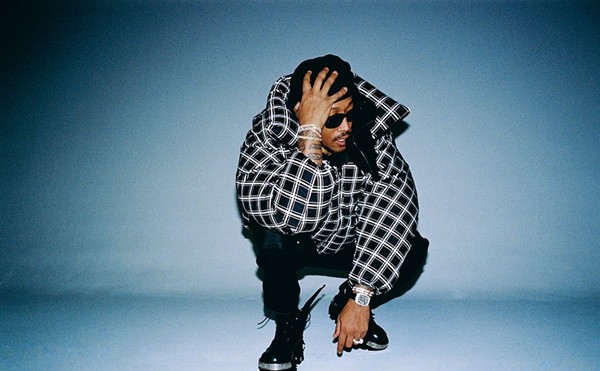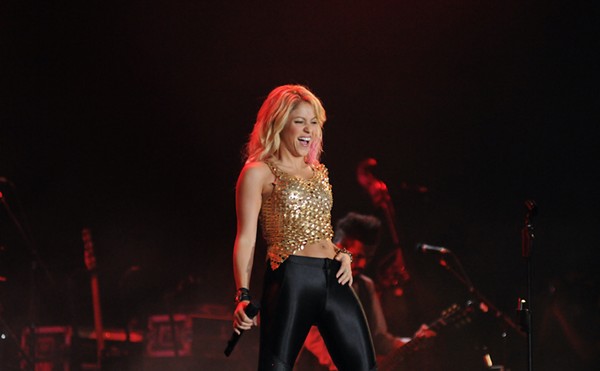Ram Won't Rest: The Viva Tacoland Brawl is Over. But the Anger Remains.
By Greg Jefferson on Tue, Jun 19, 2018 at 2:10 pm
On the main stage at Paper Tiger, Hickoids frontman Jeff Smith stopped about midway through their set on March 3 to light into Viva Tacoland, trashing the Pearl-area bar as a place where well-mannered customers “speculate on real estate” over their beers.
“That ain’t Taco Land, baby,” Smith barked into the mic. The crowd, older and grayer than you’d expect to see at Paper Tiger on a Saturday night, roared.
Viva Tacoland opened in May 2014 where the original Taco Land once stood.
The one Smith had in mind was a squat cinderblock building and beer garden beside an enormous, gnarled oak tree at the corner of Elmira and Grayson, sitting over the San Antonio River. From the early 1980s through 2005, Taco Land was the loud, chaotic heart of punk rock in San Antonio, and Ramiro “Ram” Ayala was the profane, gruff, warped father figure who lorded over the place.
Ram, who opened Taco Land in 1965, selling tacos for a dime each, was gunned down during an after-hours robbery 13 years ago.
“I’ve always been fascinated by the fact that people respected him and loved him,” Kory Cook, KRTU’s music director and former drummer for the punk band Sons of Hercules, said in a Current oral history marking the 10th anniversary of Ram’s murder. “He was a scary, mean man. He may have had love in his heart, but you couldn’t really see it unless you really got to know him. I think it comes down to the fact that people respect other people who are transparent and will be exactly who they are business-wise. He didn’t have to go to work and be nice and be fake.”
Many of Ram's friends and fans have pointedly refused to set foot in the business that operates out of the shell of their beloved dive.
Nevertheless, Viva Tacoland appears to be succeeding, though its Riverwalk offshoot — formerly The Worm Tequila and Mezcal Bar — was recently shuttered after Viva owner Chris Erck assigned the lease to another bar operator. It’s not Erck’s only recent closing – he shut down his Swig Martini Bar in 2017.
Last Saturday at about 8 p.m., Viva Tacoland’s tables were filling up with a mix of out-of-towners, young, nearby apartment dwellers and middle-age couples. The vibe was low-key, and the music playing in the background was pop. Two of Ram’s expressions – “Don’t be a pussy” and “Kiss the baby,” by which he meant take a slug from the plastic bottle of booze he carried around – were spray-painted on the walls. The fake graffiti effectively marked off Ram’s words as just another couple of empty catchphrases. A wall painting of a scowling Ram stared out on Elmira.
The bar is cleaner and more orderly than Taco Land. It sells craft beer – about 90 labels of brews total – and Viva Tacoland T-shirts. Its patrons are a diverse mix, but, by and large, there’s nothing particularly alarming or odd about them.
In other words, Viva Tacoland is a good barometer of the redevelopment or gentrification – take your pick – that’s overtaking the once-grungy Midtown area north of downtown.
“It’s totally part of the gentrification process,” said Christine Drennon, director of Trinity University’s urban studies program, of Viva Tacoland. “Gentrification isn’t just about residential and commercial properties. It’s also about the cultural amenities in a community. They’re going to shift because the demand has changed – it’s gone from one income mix to another.”
A Ditch Ran Through It
The Hickoids, a country-punk fusion, had frequently performed at Taco Land. In a recent interview, Smith said he hadn’t been in awe of Ram as so many patrons and performers had, but he respected the man and was a friend. That’s part of the reason he spoke out against Viva Tacoland that Saturday night.
The Hickoids were on the same bill as the jokey punk band the Dead Milkmen, who’d not only performed at Taco Land but recorded a song paying homage to the place. (The Milkmen were the reason the audience that night was packed with so many forty- and fiftysomethings.) Other national acts played Taco Land, too, including Yo La Tengo, GWAR and the Cramps. But Texas bands were its lifeblood. The Hickoids, Los No. 3 Dinners, Sons of Hercules, who opened the March 3 show, the Bang Gang and scores of others played there with Ram’s blessing.
On stage, Smith reminisced about when the stretch of the San Antonio River next to Taco Land was a ditch, atmospherically as far from the flashy, touristy Riverwalk as you could get. The idea of calling it part of the Museum Reach, as it is today, would have been a joke.
Chris Erck heard almost immediately about the abuse his business had taken at the Dead Milkmen show. But it was a blip compared to the vitriol he absorbed four years ago from the many friends of Ram, much of it spilling out on Facebook.
Erck had visited Taco Land twice – the first time in the early 1990s when he, a young parent at the time, turned up to support a friend whose band took the stage sometime after midnight. “It was very cool, very dive-y and a little rough, but in a good way,” he said.
Like Smith, he remembers the river reach next to Taco Land as a ditch – one lined with broken beer bottles and other debris. But he clearly doesn’t remember it fondly.
Today, standing on Grayson bridge and looking down, the water is green and its surface crowded with lily pads. Smooth walkways run along both sides of the river like concrete tracks.
Preserving History or Milking It?
Almost from the moment Erck first talked publicly about his plan for the Taco Land site – owned by Desperate Housewives actor Ricardo Chavira and developer David Adelman – he was roasted by many of Ram’s friends and one-time patrons.
“The misconception was that I was trying to profit off of somebody else’s brand, and that wasn’t the case,” Erck said. “The history of Taco Land was kind of erased. Now, there’s at least a conversation about it.”
He compared Viva Tacoland to his mid-1990s renovation of the Finesilver Building on Camaron Street downtown, one-time home of a clothing manufacturer, one of San Antonio’s major employers in its day. He housed an artists’ residency program there, created gallery space and prominently displayed the Finesilver name atop the building – at least saving the name from the memory hole, he said.
In addition to staging live music, Viva Tacoland frequently hosts art shows.
Erck said he competed against two other business developers whose proposed projects for the Grayson Street location didn’t include Taco Land in their names. But keeping some form of the name, he said, was critical to hanging on to at least part of Taco Land’s legacy.
Consider what often happens with properties like Taco Land, he said – a developer levels the site and puts up a McDonald’s or Starbucks.
Not surprisingly, there are other interpretations of Erck’s work on Grayson.
“It’s a marketing ploy. It’s a branding strategy. Everything is for sale,” Trinity University’s Drennon said. “It has value that has been turned into a money-making thing, and something is lost in that.”
Smith said Viva Tacoland, with its $3 Kiss the Baby Surprise Shots and other Ram kitsch, was turning his friend into a one-dimensional character, a cartoon.
“They’re branding something that never made any money,” he said. “Once you have completely obliterated the character of something, why do you still call it by its name?”
Before Viva Tacoland’s opening, Erck met with Smith and other former Taco Land denizens to see if a peace agreement was possible. In Smith’s account, he said to Erck, “Use some other name, and I’ll be the first to say give it a try.” Erck, for his part, recalled meeting with Smith and others, but not the details of the conversation.
His detractors almost succeeded in killing Viva Tacoland. The anticipated crowds stayed away, which Erck blames on opponents’ many attacks via social media.
“It definitely slowed our progress,” he said. He had to use money set aside for a new deck and stage for “marketing and to keep the business going. There was a period [in January 2015] where things were really lean. There was concern that we weren’t going to make it.”
But Viva Tacoland found its customers within a few months.
Plans now include building decks down to the Riverwalk. “Weekends it gets pretty crowded, and we need that extra space.”
From Grit to Glam
Viva Tacoland is part of the transformation that’s grinding to atoms the old midtown – a one-time precinct of drug dealers and their buyers, prostitutes and their customers, dark streets and boarded-up businesses. It was one of the parts of San Antonio where the economy ran out of gas. City officials ignored it. It would’ve looked more than weird to have a glittering Museum Reach flowing through the urban decay out of which Taco Land grew.
The 1.3-mile Museum Reach, completed in 2009 at a cost of $72 million, did what it was supposed to do – it brought redevelopment to midtown. Real-estate development firm Silver Ventures, backed by billionaire Christopher “Kit” Goldsbury, and its Pearl Brewery were immediate beneficiaries of the project. Silver Venture's massive investment, in turn – and in combination with the new Museum Reach – sparked a lot of residential and commercial development on the Pearl’s perimeter and beyond, including apartments, restaurants, bars, hotels and office buildings.
By the time Viva Tacoland opened in 2014, the Museum Reach had already unleashed more than $250 million in private investment, according to a study released at the time by the San Antonio River Authority.
The pace hasn’t slowed.
“The whole urban core is exploding, and we’re seeing it all of emanate from [the Pearl area]. This is ground zero,” said Michael Amezquita, chief appraiser of the Bexar Appraisal District. “We see some of the highest rents in the city here.”
The median sales price for condos and houses in the Pearl area, part of the Tobin Hill neighborhood, has more than doubled since 2006 – from $147,000 to $338,000.
Viva Tacoland is located on a seam joining the new and old Tobin Hill. From its patio, customers look out on the river, the tourists and runners on the walkways, and the Pearl – a gold- and brown-hued skyline onto itself – a little beyond them. To the north and next door, on the other hand, are vacant buildings with “for lease” signs stuck to their weather-beaten facades.
But the area’s future is probably better represented by the lot directly across Grayson from Viva Tacoland. Crews there are preparing the site for a four-story apartment building. Sitting at one of Viva Tacoland’s picnic tables, I asked Erck what he expected to see to the north in the next 10 years. “I suspect a lot of residential, a lot of taller buildings, a lot more verticality – a true Midtown,” he said.
Erck said that’s part of what made the Viva Tacoland project attractive – that and the chance to preserve some of Taco Land’s history.
But others are struck more by what’s been lost.
There was a lot about Taco Land “that epitomizes the city,” Christine Drennon said. “It was kind of edgy. It was scruffy. It was more Latino. And that’s being appropriated and changed.”
Stay on top of San Antonio news and views. Sign up for our Weekly Headlines Newsletter.
“That ain’t Taco Land, baby,” Smith barked into the mic. The crowd, older and grayer than you’d expect to see at Paper Tiger on a Saturday night, roared.
Viva Tacoland opened in May 2014 where the original Taco Land once stood.
The one Smith had in mind was a squat cinderblock building and beer garden beside an enormous, gnarled oak tree at the corner of Elmira and Grayson, sitting over the San Antonio River. From the early 1980s through 2005, Taco Land was the loud, chaotic heart of punk rock in San Antonio, and Ramiro “Ram” Ayala was the profane, gruff, warped father figure who lorded over the place.
Ram, who opened Taco Land in 1965, selling tacos for a dime each, was gunned down during an after-hours robbery 13 years ago.
“I’ve always been fascinated by the fact that people respected him and loved him,” Kory Cook, KRTU’s music director and former drummer for the punk band Sons of Hercules, said in a Current oral history marking the 10th anniversary of Ram’s murder. “He was a scary, mean man. He may have had love in his heart, but you couldn’t really see it unless you really got to know him. I think it comes down to the fact that people respect other people who are transparent and will be exactly who they are business-wise. He didn’t have to go to work and be nice and be fake.”
Many of Ram's friends and fans have pointedly refused to set foot in the business that operates out of the shell of their beloved dive.
Nevertheless, Viva Tacoland appears to be succeeding, though its Riverwalk offshoot — formerly The Worm Tequila and Mezcal Bar — was recently shuttered after Viva owner Chris Erck assigned the lease to another bar operator. It’s not Erck’s only recent closing – he shut down his Swig Martini Bar in 2017.
Last Saturday at about 8 p.m., Viva Tacoland’s tables were filling up with a mix of out-of-towners, young, nearby apartment dwellers and middle-age couples. The vibe was low-key, and the music playing in the background was pop. Two of Ram’s expressions – “Don’t be a pussy” and “Kiss the baby,” by which he meant take a slug from the plastic bottle of booze he carried around – were spray-painted on the walls. The fake graffiti effectively marked off Ram’s words as just another couple of empty catchphrases. A wall painting of a scowling Ram stared out on Elmira.
The bar is cleaner and more orderly than Taco Land. It sells craft beer – about 90 labels of brews total – and Viva Tacoland T-shirts. Its patrons are a diverse mix, but, by and large, there’s nothing particularly alarming or odd about them.
In other words, Viva Tacoland is a good barometer of the redevelopment or gentrification – take your pick – that’s overtaking the once-grungy Midtown area north of downtown.
“It’s totally part of the gentrification process,” said Christine Drennon, director of Trinity University’s urban studies program, of Viva Tacoland. “Gentrification isn’t just about residential and commercial properties. It’s also about the cultural amenities in a community. They’re going to shift because the demand has changed – it’s gone from one income mix to another.”
A Ditch Ran Through It
The Hickoids, a country-punk fusion, had frequently performed at Taco Land. In a recent interview, Smith said he hadn’t been in awe of Ram as so many patrons and performers had, but he respected the man and was a friend. That’s part of the reason he spoke out against Viva Tacoland that Saturday night.
The Hickoids were on the same bill as the jokey punk band the Dead Milkmen, who’d not only performed at Taco Land but recorded a song paying homage to the place. (The Milkmen were the reason the audience that night was packed with so many forty- and fiftysomethings.) Other national acts played Taco Land, too, including Yo La Tengo, GWAR and the Cramps. But Texas bands were its lifeblood. The Hickoids, Los No. 3 Dinners, Sons of Hercules, who opened the March 3 show, the Bang Gang and scores of others played there with Ram’s blessing.
On stage, Smith reminisced about when the stretch of the San Antonio River next to Taco Land was a ditch, atmospherically as far from the flashy, touristy Riverwalk as you could get. The idea of calling it part of the Museum Reach, as it is today, would have been a joke.
Chris Erck heard almost immediately about the abuse his business had taken at the Dead Milkmen show. But it was a blip compared to the vitriol he absorbed four years ago from the many friends of Ram, much of it spilling out on Facebook.
Erck had visited Taco Land twice – the first time in the early 1990s when he, a young parent at the time, turned up to support a friend whose band took the stage sometime after midnight. “It was very cool, very dive-y and a little rough, but in a good way,” he said.
Like Smith, he remembers the river reach next to Taco Land as a ditch – one lined with broken beer bottles and other debris. But he clearly doesn’t remember it fondly.
Today, standing on Grayson bridge and looking down, the water is green and its surface crowded with lily pads. Smooth walkways run along both sides of the river like concrete tracks.
Preserving History or Milking It?
Almost from the moment Erck first talked publicly about his plan for the Taco Land site – owned by Desperate Housewives actor Ricardo Chavira and developer David Adelman – he was roasted by many of Ram’s friends and one-time patrons.
“The misconception was that I was trying to profit off of somebody else’s brand, and that wasn’t the case,” Erck said. “The history of Taco Land was kind of erased. Now, there’s at least a conversation about it.”
He compared Viva Tacoland to his mid-1990s renovation of the Finesilver Building on Camaron Street downtown, one-time home of a clothing manufacturer, one of San Antonio’s major employers in its day. He housed an artists’ residency program there, created gallery space and prominently displayed the Finesilver name atop the building – at least saving the name from the memory hole, he said.
In addition to staging live music, Viva Tacoland frequently hosts art shows.
Erck said he competed against two other business developers whose proposed projects for the Grayson Street location didn’t include Taco Land in their names. But keeping some form of the name, he said, was critical to hanging on to at least part of Taco Land’s legacy.
Consider what often happens with properties like Taco Land, he said – a developer levels the site and puts up a McDonald’s or Starbucks.
Not surprisingly, there are other interpretations of Erck’s work on Grayson.
“It’s a marketing ploy. It’s a branding strategy. Everything is for sale,” Trinity University’s Drennon said. “It has value that has been turned into a money-making thing, and something is lost in that.”
Smith said Viva Tacoland, with its $3 Kiss the Baby Surprise Shots and other Ram kitsch, was turning his friend into a one-dimensional character, a cartoon.
“They’re branding something that never made any money,” he said. “Once you have completely obliterated the character of something, why do you still call it by its name?”
Before Viva Tacoland’s opening, Erck met with Smith and other former Taco Land denizens to see if a peace agreement was possible. In Smith’s account, he said to Erck, “Use some other name, and I’ll be the first to say give it a try.” Erck, for his part, recalled meeting with Smith and others, but not the details of the conversation.
His detractors almost succeeded in killing Viva Tacoland. The anticipated crowds stayed away, which Erck blames on opponents’ many attacks via social media.
“It definitely slowed our progress,” he said. He had to use money set aside for a new deck and stage for “marketing and to keep the business going. There was a period [in January 2015] where things were really lean. There was concern that we weren’t going to make it.”
But Viva Tacoland found its customers within a few months.
Plans now include building decks down to the Riverwalk. “Weekends it gets pretty crowded, and we need that extra space.”
From Grit to Glam
Viva Tacoland is part of the transformation that’s grinding to atoms the old midtown – a one-time precinct of drug dealers and their buyers, prostitutes and their customers, dark streets and boarded-up businesses. It was one of the parts of San Antonio where the economy ran out of gas. City officials ignored it. It would’ve looked more than weird to have a glittering Museum Reach flowing through the urban decay out of which Taco Land grew.
The 1.3-mile Museum Reach, completed in 2009 at a cost of $72 million, did what it was supposed to do – it brought redevelopment to midtown. Real-estate development firm Silver Ventures, backed by billionaire Christopher “Kit” Goldsbury, and its Pearl Brewery were immediate beneficiaries of the project. Silver Venture's massive investment, in turn – and in combination with the new Museum Reach – sparked a lot of residential and commercial development on the Pearl’s perimeter and beyond, including apartments, restaurants, bars, hotels and office buildings.
By the time Viva Tacoland opened in 2014, the Museum Reach had already unleashed more than $250 million in private investment, according to a study released at the time by the San Antonio River Authority.
The pace hasn’t slowed.
“The whole urban core is exploding, and we’re seeing it all of emanate from [the Pearl area]. This is ground zero,” said Michael Amezquita, chief appraiser of the Bexar Appraisal District. “We see some of the highest rents in the city here.”
The median sales price for condos and houses in the Pearl area, part of the Tobin Hill neighborhood, has more than doubled since 2006 – from $147,000 to $338,000.
Viva Tacoland is located on a seam joining the new and old Tobin Hill. From its patio, customers look out on the river, the tourists and runners on the walkways, and the Pearl – a gold- and brown-hued skyline onto itself – a little beyond them. To the north and next door, on the other hand, are vacant buildings with “for lease” signs stuck to their weather-beaten facades.
But the area’s future is probably better represented by the lot directly across Grayson from Viva Tacoland. Crews there are preparing the site for a four-story apartment building. Sitting at one of Viva Tacoland’s picnic tables, I asked Erck what he expected to see to the north in the next 10 years. “I suspect a lot of residential, a lot of taller buildings, a lot more verticality – a true Midtown,” he said.
Erck said that’s part of what made the Viva Tacoland project attractive – that and the chance to preserve some of Taco Land’s history.
But others are struck more by what’s been lost.
There was a lot about Taco Land “that epitomizes the city,” Christine Drennon said. “It was kind of edgy. It was scruffy. It was more Latino. And that’s being appropriated and changed.”
Stay on top of San Antonio news and views. Sign up for our Weekly Headlines Newsletter.
Tags:

KEEP SA CURRENT!
Since 1986, the SA Current has served as the free, independent voice of San Antonio, and we want to keep it that way.
Becoming an SA Current Supporter for as little as $5 a month allows us to continue offering readers access to our coverage of local news, food, nightlife, events, and culture with no paywalls.
Scroll to read more Music Stories & Interviews articles
Newsletters
Join SA Current Newsletters
Subscribe now to get the latest news delivered right to your inbox.

